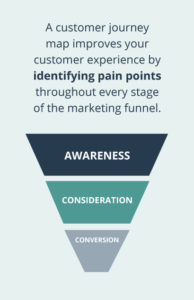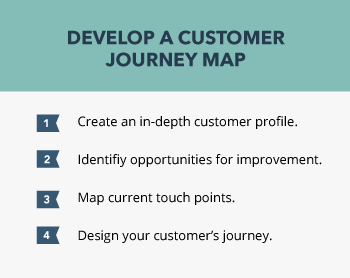When customers consider your company versus your competitor, how can you make sure you’re the obvious choice? How can you ensure you’re providing a premium experience as people transition from a curious lead to a paying customer?
Sometimes, customers get stuck in the marketing funnel. They know your company, they know your offer, and they’ve even expressed interest, but they never seem to make it to the bottom of your funnel and convert.
These are common challenges for many companies, and often these issues are due to a lack of clarity around your customer’s journey. If you want to be the solution to your customer’s problems, you must demonstrate an understanding of their pain points. A customer journey map can help you.
By addressing the hesitations your target customer has at different stages of your marketing funnel, a customer journey map can help marketers overcome objections—right from the start.
Why are Customer Journey Maps Important?
When done correctly, customer journey maps can unlock the answers to lingering questions, create a clear path forward, and provide a single resource for teams to reference. Here are two reasons why customer journey maps are important.
They improve customer experience.
A customer journey map improves your customer experience by identifying pain points throughout every stage of the marketing funnel (awareness, consideration, and conversion). When you understand the pain points, you can create touch points that reassure your customers.
For example, when leads are in the consideration stage, they are researching your offer, pricing, and your competitors. A common frustration at this stage is difficulty finding pricing. When you know this about your customer, you may decide to make your pricing easier to find on your website.
If your pricing varies, or it’s not industry standard to include this information immediately, you may consider sharing a pricing range. This one change can put you miles ahead of your competitors.
They provide a fix for your “leaky funnel” problem.
What is a “leaky funnel” in marketing? Simply, you have plenty of leads at the top of your funnel that have shown interest in your company, but as they move down the funnel from brand awareness to consideration, they disappear.
Why? This can occur for a number of reasons: frustration finding information, confusion over the buying process, not enough education about your offer, and more.
You know not everyone at the top of the funnel makes it to the conversion phase, but are you leaving money on the table by not addressing the pain points that send people running?
A customer journey map provides a visualization of your customer journey, the interactions they have with your company, and clarity on how these touch points can be leveraged to keep people moving through the funnel.
Developing a Customer Journey Map
Recently, one of our clients came to us wanting to learn more about their customer’s experience, hoping to anticipate questions so they could better provide answers. We knew a customer journey map was the answer, so we set to work researching and developing their tailored journey map. Here’s how we did it.

- Created an in-depth customer profile.
We did a deep dive into their target audience. This is an essential first step, as sometimes a company’s instincts about their ideal customer aren’t backed up by data. We looked at their target audience’s interests, preferred methods of communication, and how they discover new brands. This data helped us create a picture of their ideal customer.
- Identified opportunities for improvement.
Our next step was to solicit feedback from the marketing department, sales team, and operations team to find areas for improvement. These departments get first-hand feedback from potential and current customers, making them valuable groups to learn about customer complaints and pain points.
3. Mapped current touch points.
Next, we mapped our client’s customers’ current interactions and touch points. For example, were they seeing ads in the awareness phase, participating in a webinar in the consideration phase, and requesting a quote for services in the conversion phase?
We listed all the interactions customers had with our client and categorized them into the three phases: awareness, consideration, and conversion. We considered how we could leverage these touch points to address pain points and looked for opportunities to create additional interactions.
4. Designed their customer’s journey.
Finally, we took all the information gathered and designed a visualization of their customer’s journey. This critical final step provided a clear path forward for addressing customer needs so they could smoothly continue through the funnel.
Customer Journey Mapping & Digital Marketing Services in Portland
A well-researched and designed customer journey map elevates the experience for your customers, improves existing marketing funnels, and provides a critical resource for your team. Need help creating your customer journey map? Get in touch with our marketing experts and improve your customer journey today.

